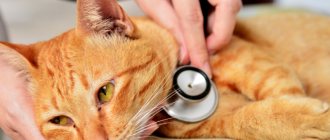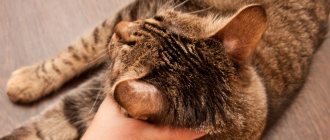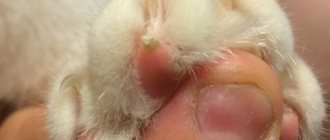Pulmonary edema in a cat or acute pulmonary failure is not an independent disease, but a complication of certain ailments of a cardiogenic or non-cardiogenic nature. It is accompanied by acute suffocation, progressing as the swelling increases. If veterinary care is late, the animal dies from asphyxia. In the article we will look at the causes of pulmonary failure in animals, answer the questions: why the disease is fatal, whether the pathology can be cured, what preventive measures exist.
What it is
The process of breathing in animals, as in humans, occurs with the participation of alveoli - peculiar bubble formations in the lungs, intertwined with a network of blood vessels. Under normal conditions, the alveoli of the lungs during inhalation are filled with oxygen entering the blood, which then carries it to the brain, nourishes the heart and tissues. When you exhale, exhaust air containing carbon dioxide is released through the alveoli.
In pulmonary insufficiency (edema), for various reasons, transudate (edematous fluid) and the liquid part of the blood enter the alveoli - infiltration. A sharp decrease in the working volume of the lungs disrupts the breathing process and leads to progressive oxygen starvation of the body.
Symptoms
Lethargy, inactivity and lack of appetite in a cat are the first warning signs of pulmonary edema. These harmless signs are characteristic of many diseases, so owners do not immediately begin to sound the alarm. The owner needs to carefully monitor the pet’s behavior, mood and appetite. But the animal does not eat or move, because it has suddenly lost its breath and cannot breathe freely. The mouth opens slightly in an attempt to swallow more air, the tongue hangs lifelessly, and the gaze becomes lost and meaningless.
If suddenly these few signs did not help to detect the cat’s illness, then the following signs should definitely alert the owners. Suddenly wheezing or gurgling appears, the cat begins to breathe convulsively with an open mouth like a dog and walk restlessly. She may have a wet cough with bloody mucus or foam. The cat can lie on its belly with its paws spread wide, and then simply assume a side position. Body temperature may drop sharply, this can be determined by cold extremities. The cat's belly begins to shake, trembling occurs in the area of the withers, and the heartbeat quickens.
Not all symptoms may occur at the same time. Often one is replaced by another, which makes it difficult to make a prompt diagnosis. Symptoms may appear in waves or occur rapidly, bringing the cat closer to death. The cat must be urgently hospitalized.
Causes of the disease
Pulmonary failure in cats almost always develops as a complication of heart disease, but it can also have a different, non-cardiogenic nature.
Cardiogenic pulmonary edema
The most common cause of pulmonary edema is progression of heart failure in cats. Heart failure develops due to disruption of the left ventricle of the heart. This provokes pathology of the pulmonary circulation and swelling in various organs and tissues, including the lungs. Cardiogenic edema accompanies the following diseases:
- cardiomyopathy;
- aortic insufficiency;
- mitral stenosis of the heart;
- pulmonary embolism;
- myocarditis;
- hypertension;
- infective endocarditis.
Cardiogenic pulmonary edema in cats is characterized by a gradual filling of the alveoli with fluid, an increase in oxygen starvation of tissues, turning into asphyxia. In this case, in order to save the animal, resuscitation measures cannot be avoided.
Non-cardiogenic edema
Infectious and non-infectious ailments that may be complicated by pulmonary insufficiency are:
- diseases of the respiratory system: pneumonia, bronchial asthma, tuberculosis, chest injuries, inhalation of volatile toxic substances;
- diseases of the excretory system: nephritis, renal failure;
- Gastrointestinal diseases: pancreatitis, intestinal obstruction, volvulus;
- diseases of the nervous system: encephalitis, meningitis, brain tumors, reaction to anesthesia after sterilization or castration;
- complications of infectious diseases: influenza, inflammation of the upper respiratory tract, plague;
- severe allergic reactions.
Predisposition to disease
Pulmonary edema of a cardiogenic nature more often occurs in cats of certain breeds that have a hereditary tendency to cardiovascular pathologies. This breed defect is inherent in many artificially bred cat breeds:
- sphinxes;
- Maine Coon;
- the British;
- Scottish Fold;
- Persian and representatives of other breeds.
Kittens more often suffer from traumatic pulmonary edema. The pathology develops in them after chest injuries, to which they are very susceptible.
There is no difference in the incidence of this pathology between males and females.
Treatment of edema
This type of disorder requires intensive therapy, as the disease is deadly. First, they give oxygen therapy, which should help the cat survive. During the procedure, the animal breathes through a mask of air. If the cause is a foreign body entering the lung, then a tracheostomy is performed - a surgical procedure in which the trachea is taken out to clean. After surgery, medications are used to restore the cat's health to help treat the symptoms of the disorder. The characteristics of the drugs are shown in the table:
| A drug | Description |
| "Furosemide" | Removes liquid |
| "Trimetaphane" | Restores heart function |
| "Cocarboxylase" | |
| "Sulfocamphocaine" | Improves breathing ability |
| "Dexamethasone" | Fights inflammatory processes |
Types of disease
Based on the rate of progression of symptoms, several types of disease are distinguished:
- Lightning fast - has rapid development, leading to rapid death.
- Acute - characterized by a high rate of development. Symptoms increase over several hours. In this case, prompt treatment is the only way to save the animal.
- Subacute - has a wave-like development. Periods of increasing symptoms are followed by periods of subsiding.
- Protracted - has erased symptoms. Characteristic of chronic pathologies.
Prevention
Preventing the development of the disease involves monitoring the health of the animal. This especially applies to cats with weakened immune systems and breeds that are more susceptible to edema. It is these sick animals that should be checked by doctors every six months. The animal must be kept in comfortable conditions with a favorable temperature. Excessive physical activity should not be allowed. It is also important to give your cat the necessary vitamins and vaccinations. It is important to treat the original source of the disorder so as not to provoke a relapse.
Symptoms of the disease
In cats, symptoms of pulmonary edema include signs of oxygen deprivation. Their onset may be preceded by a characteristic state of the animal, indicating a deterioration in health. This is anxiety, hoarse cough, refusal to eat, pallor of the mucous membranes.
With an increase in oxygen deficiency in the tissues, the animal begins to suffocate. The state of lack of air is determined by the specific behavior of the cat:
- heavy breathing with an open mouth and protruding tongue;
- a position in which it is easier to breathe: paws widely spaced, neck elongated and head lowered;
- cold paws;
- bluish mucous membranes of the lips and nose;
- abdominal breathing.
Main symptoms
At the initial stage, pulmonary edema may not manifest itself in any way. Cats cannot speak, so even if something bothers them, they will not be able to tell their owner about it. An attentive owner may suspect pathology based on changes in the pet's behavior.
The animal becomes lethargic, restless and prefers to lie in one position - on its side. Typical symptoms of pulmonary edema include:
- hoarse breathing with gurgling;
- dyspnea;
- lack of appetite;
- open mouth with tongue hanging out;
- mucous membranes acquire a bluish tint or turn pale;
- mucus discharge from the nose;
- arrhythmia;
- cough with expectoration of mucus (sometimes with blood).
If you find these dangerous symptoms in your pet, take him to the veterinary clinic immediately!
Remember that pulmonary edema can progress rapidly, and the count is not even in days, but in hours!
First aid before going to the veterinary clinic
If there are signs of pulmonary edema, immediate assistance to the animal is very important, since it determines whether resuscitation will be successful. Before delivering the cat to the clinic, it is necessary to make the breathing process as easy as possible for her using improvised methods:
- give an injection of a diuretic (Furosemide);
- open the windows or take the cat out into the fresh air;
- provide the animal with complete rest and limit physical activity;
- do not disturb or take any forceful action towards him;
- deliver to the clinic as quickly as possible;
- During transportation, it is advisable to place the animal on its side.
If first aid is provided correctly, then subject to a professional approach to the choice of treatment method, there is hope that the animal will recover.
Treatment method and prognosis
There is no single treatment regimen for pulmonary edema; it will depend on the cause that caused the pathological process and, accordingly, is aimed at eliminating it.
If the condition is critical, the animal must be given first aid. To do this, the cat is given an intramuscular injection of a drug that relieves swelling and eliminates hypoxia - Prednisolone, Dexamethasone, Diprospan, Hydrocortisone.
Oxygen replenishment is carried out by placing the pet in a pressure chamber, using an oxygen mask, and performing pulmonary ventilation procedures.
To remove excess fluid, diuretics are used (injected or orally).
To eliminate the infectious diseases that caused the edema, a course of antibiotic therapy is prescribed. For viral etiology of edema, antiviral agents are indicated.
During illness, cats usually experience severe stress, so they are prescribed sedatives.
If, after carrying out the necessary medical procedures, the cat’s condition has stabilized and his health is no longer in danger, the fluffy cat is sent home to recover.
If all first aid measures and further treatment were carried out correctly, the prognosis is positive. However, if a sick pet is brought to the clinic too late, the risk of death is very high.
Diagnosis of the disease
Diagnostic procedures should be as prompt as possible, since suffocation can progress rapidly. Sometimes it is advisable to start treatment procedures in parallel with diagnostics, so as not to miss time. Basic diagnostic measures:
- A detailed survey of the owner about the behavior and well-being of the animal since the moment of illness.
- External examination and auscultation (listening) of the lungs and heart.
- X-ray examination of the chest. Based on the pulmonary pattern, one can determine the nature of the pathology, since areas of the lungs that do not take part in the breathing process and the level of fluid in the alveoli are visible. Pathological changes in the heart muscle are also determined. X-rays also help to carry out differential diagnosis, which makes it possible to separate the disease from other pathologies of the heart and respiratory system.
- Ultrasound of the heart is prescribed if a cardiogenic origin of the disease is suspected, to determine how much the contractility of the left ventricle is altered.
- An electrocardiogram provides information about the presence of ventricular hypertrophy, arrhythmias and ischemia of the heart muscle.
- A general and biochemical blood test will complement the picture of the disease with a number of clinical signs.
Diagnostics
Comprehensive diagnosis of the disease includes:
- Chest X-ray.
- Echocardiography - ultrasound of the heart.
- Listening with a stethoscope.
- Analysis of urine.
- General blood analysis.
- Blood test for biochemistry.
The test results are processed by a specialist to determine the root cause of the swelling.
Important!
The diagnosis of pulmonary edema cannot be made solely on the basis of anamnesis and examination of the pet - remember this when choosing a clinic and attending physician!
Treatment of the disease
Treatment of pulmonary edema begins with resuscitation measures designed to support the cat’s life. First of all, this is oxygen therapy, which consists of forcing the cat to breathe through a special mask where oxygen is supplied or placing it in an oxygen chamber for a certain time.
If the cause of pulmonary insufficiency is a foreign body or vomit entering the respiratory tract (aspiration), then they are removed by tracheostomy (extending the trachea).
The main treatment consists of drug therapy:
- getting rid of swelling and excess fluid in tissues - diuretics, diuretics (Furosemide);
- normalization of heart function - drugs that relieve heart failure and affect tissue metabolism (Carboxylase);
- decreased pressure in the pulmonary circulation - ganglion blockers (Bromide, Trimetaphan);
- stimulation of breathing - drugs that stimulate the parts of the brain responsible for breathing (Sulfocamphocaine);
- relieving inflammation - antihistamines (Dexamethasone);
- If pulmonary edema occurs in a cat due to a bacterial infection, then treatment with antibiotics is started.
After the acute condition has been relieved, therapy for the underlying disease begins, during which medications of various types are used, according to indications, depending on the nature of the disease.
Treatment of pulmonary edema and associated diseases should only take place in a hospital, since the serious condition of the animal requires constant medical supervision.
Diagnosis of pulmonary edema
Diagnosis of pulmonary edema in cats is based on medical history, clinical symptoms, auscultation (listening to lung sounds) and radiography. However, if the cat is in critical condition and there is a threat to life, primary treatment should be carried out without additional diagnostics until the condition has stabilized.
After relief of the acute condition (the treatment algorithm is similar, regardless of the cause), additional diagnostics should be carried out to determine the cause.
Disease prevention
There are no special preventive measures to protect against the disease. Prevention consists of careful monitoring of animals that are at risk for cardiovascular and colds. These are predisposed breeds (Maine Coons, Sphynxes, Persians, Scottish, British), weakened, with low immunity, overweight, animals that move little.
If the disease is cured in time, then we can say with a high degree of confidence that complications will not develop.
The main preventive measures are:
- protect the cat from physical overload;
- protect from unfavorable environmental conditions (avoid overheating and hypothermia, being in drafts);
- monitor the safety of cats and kittens at home (protect access to wires and electrical appliances, ensure that the animal cannot inhale fumes of aggressive chemicals, protect from falls and injuries);
- strengthen the immune system, do not skip scheduled vaccinations;
- undergo regular preventive examinations with a veterinarian.
The disease often has a poor prognosis. But the attention and love of the owner can work a miracle. Competent and timely veterinary care (especially in non-cardiogenic disease) makes the chances of recovery quite high.
Preventing pulmonary edema in cats
If we are talking about animals with previously diagnosed cardiac pathology, regular examination of the animal by veterinary specialists, accurate determination of the functional degree of heart failure and timely treatment will help avoid the development of pathology.
Prevention of cardiogenic edema in young, clinically healthy animals involves conducting screening studies before surgery, this is especially important if the cat belongs to risk breeds.
(c) Veterinary center for the treatment and rehabilitation of animals “Zoostatus”. Varshavskoe highway, 125 building 1. tel. 8 (499) 372-27-37
Forecast
In 9 out of 10 cases, the prognosis for thoracic hydrops is cautious or unfavorable. This is due to the fact that hydrothorax causes venous stagnation, impedes lymphatic drainage, and fills the pleural cavity with edematous fluid (transudate). Against the background of this condition, tissue gas exchange is disrupted. All this leads to dysfunction of the heart muscle, so death is possible.
The accumulation of edematous fluid (transudate) in the pleural area of a cat leads to displacement of lung volume. This causes a decrease in tidal volume, which causes shortness of breath and even respiratory failure. In this case, the cat experiences panic, is afraid to lie down and most often sits to make it easier to breathe.
In especially severe cases, the animal does not sleep. Not only does his breathing become difficult, but his general health also worsens. Panic attacks develop. Taking a horizontal position, cats in some cases cannot breathe. All this is reflected not only in her behavior, but also in the state of the entire organism.
If your cat exhibits symptoms of hydrothorax, contact a professional veterinarian immediately. This will increase your pet’s chances of recovery and ensure a quick recovery of his body!
Consequences
If it is too late to notice pulmonary edema in a kitten, then its body, weakened due to age, may not be able to cope with such a pathology at all. Adults are not immune from death, because everything depends primarily on the severity of the edema. Without proper treatment, such inflammation will cause serious disruptions in the functioning of the lungs, heart, brain and other organs due to a simple lack of oxygen.
The process of treating pulmonary edema in cats requires constant monitoring by veterinarians. Thus, it is important to monitor intravenous pressure, blood composition, color of mucous membranes, biochemical balance in the body, and also periodically take x-rays. If all this is not done, the consequences will vary from relative recovery (if the swelling was caused by an allergy) to a malfunction of the lungs and, as a consequence, the whole body.
Diagnosis of the disease
The first step in treating hydrothorax is diagnosis. The veterinarian needs to confirm the diagnosis, determine the cause of the disease and make a prognosis. To do this, a clinical examination is carried out, an anamnesis is collected (the cat's owner is interviewed) and additional diagnostic methods are used for greater accuracy.
At the discretion of the veterinarian, the following is prescribed:
- radiographic examination,
- thoracentesis with fluid analysis,
- blood test (clinical/biochemical),
- scatological research, etc.
Based on the diagnostic data obtained, the veterinarian develops a treatment plan for hydrothorax in the cat.
Causes
Pulmonary edema in cats develops as a result of various causes. But it is worth remembering that this pathology is not a disease. Pulmonary edema is a serious symptom and type of complication that occurs against the background of an underlying illness.
Pulmonary edema in cats is divided into two main types:
- cardiogenic pulmonary edema in cats;
- swelling not associated with diseases of the cardiovascular system.
Cardiogenic
Very often, the cause of pulmonary edema in cats lies in heart disease. Some destructive processes in the heart and blood vessels lead to a deterioration in the flow of blood and lymph, as a result of which fluids stagnate and begin to fill the lungs.
Lung tissue itself is very porous, and it is full of cells, which is why this organ suffers in the first place. Cardiogenic pulmonary edema in cats is characterized by a gradual filling of the alveoli with fluid, an increase in oxygen starvation of tissues, turning into asphyxia. In this case, in order to save the animal, resuscitation measures cannot be avoided.
Cardiogenic pulmonary edema in a cat occurs when:
- Hypertrophic cardiomyopathy.
- Chronic heart valve diseases.
- Heart defect.
- Heart failure.
- Arterial hypertension.
- Cardiosclerosis.
- Pulmonary embolism.
Heart disease can be congenital or acquired. Cats of artificially bred breeds suffer from similar ailments more often.
Non-cardiogenic
The cause of pulmonary edema can also lie in injuries, disorders in the body, infectious diseases, and others:
- Allergic reactions (including to anesthesia).
- Aspiration pneumonia.
- Injuries to internal organs as a result of falls from height.
- Electric shock.
- Choking (carbon smoke poisoning).
- Anemia.
- Heatstroke.
- Lung cancer.
- Laryngeal paralysis.
- Head injuries: bruise and concussion.
- Severe stress.
- Injuries to internal organs during sterilization/castration operations.
- Poisoning with poisons and chemicals.
- Bacterial blood infections.
- Pancreatitis.
- Prolonged seizures (epilepsy).
- Poisonous snake bites.
- Uremia is intoxication resulting from renal failure.
- Anorexia.
- Sepsis.
- Aspiration is the entry of vomit into the respiratory tract.
Many owners who love to overfeed their pets are unaware that obesity leads to heart disease. This, in turn, entails other problems, including swelling of the organs.










